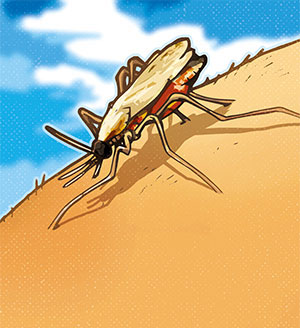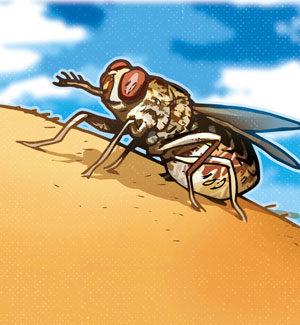By continuing your visit to this site, you accept the use of cookies.
Learn + I agreeRisks

Risk number 1 : insecte bite
In the tropics, many germs are transmitted to humans by flies and mosquitoes. Depending on the region, different germ-transmitting insect species can be found.

However, all of them operate in the same way: they bite to feed off blood and in the meantime transmit the diseases to us. Don’t act careless by walking around with bare arms and legs in areas where there are many bloodsucking flies and mosquitos.

Let’s familiarize ourselves with the main disease-carrying insect found in tropical countries:
- The tiger mosquito.
It is native of South East Africa, but we can find it nowadays on all continents and in non-tropical areas. Recently, the tiger mosquito has been found in southern Europe and keeps on advancing further north crossing the Alps, aided by increasing temperature. In Switzerland, it has been established in Ticino since 2003 and there are already a few of them showing up close to the German and French border. The mosquito owes its name to the black and white stripes on its body and legs as well as its aggressivity. The female bites during the day but mainly at dawn and dusk, and it can transmit about thirty different viruses including the Chikungunya virus, Zika virus1, Dengue fever2 or the yellow fever3.

- The anopheles.
There are 464 different species and 68 of them can transmit malaria, a disease mainly caused by the Plasmodium falciparum. Four additional Plasmodium species can cause this disease. These mosquitoes are mainly found in sub-Saharan Africa and Asia. Females bite at dusk and dawn. Anopheles are easily recognizable by their forward tilted stand with the head towards the ground and the bottom up in the air.

- The Tsetse fly.
It mainly lives in Africa where it is active during the day. This fly is the main vector of the African trypanosomiasis disease, also called sleeping sickness caused by the parasite Trypanosoma brucei. This fly has quite a surprising reproduction mode for an insect. It doesn’t lay eggs but directly gives birth to a larva that the mother develops during about 10 days in its uterus, feeding it by milk secretion, almost like mammals. In tsetse flies, both males and females are bloodsucking flies.

- Sand-fly or Phlebotominae.
It is a tiny fly, barely bigger than a gnat but that can transmit serious diseases such as leishmania4. The fly is mostly active in the evening and during the night. - Bloodsucking fleas.
These insects, exclusively found in South and Central America, deposit poop on the skin containing a parasite Trypanosoma cruzi, responsible for Chagas disease5. The parasite will then cross the skin through bite or scratch lesions.
Any other risks ?
- Untreated water and raw food such as fruit and salads can lead to traveler’s diarrhea. It’s a harmless gastroenteritis7 that will still ruin your vacation for a couple of days. It is usually caused by enterotoxigenic Escherichia coli (ETEC).
- Food that has been contaminated with poop from the African rat can lead to Lassa virus infections, causing hemorrhagic8 fever.


Dogs with rabies
Rabies is not commonly found in Europe. In Asia and Africa the virus is still highly present and is mostly transmitted by dog bites. This disease is almost always fatal once the symptoms appear. However, there is a very efficient treatment that can be given shortly after infection. If you ever get bitten or scratched in a rabies high-risk country, you must consult a doctor instantly. In addition there is a vaccine against rabies that is recommended for longer stays in an endemic country, especially if risky behavior such as bicycling is planned.
Zika Virus1 = transmitted by mosquitoes, the Zika virus causes a disease that usually is benign with various symptoms such as fever, headaches, a skin rash, some fatigue and some muscular and joint pains. However, in pregnant women, this virus can be the cause of microcephaly, a severe malformation of the fetus, causing mental retardation.
Dengue fever2 = Tropical disease transmitted by mosquitoes of the day-biting Aedes genre. Patients usually suffer of fever and headaches, with some muscular and joint pains sometimes associated with a skin rash. Dengue fever spontaneously heals in about ten days, but serious deadly complications can occur. They present with spontaneous bleedings, from the nose, gums as well as skin.
Yellow fever3 = Tropical disease from Africa and America transmitted by mosquitoes. It initially causes fever, shivers, muscle pain and headaches. In the severe form later on, people can experience vomiting as well as having their liver and kidneys affected. Coma and death will then occur in 50 to 80% of the cases. Thankfully, there is a safe vaccine against yellow fever, besides mandatory to travel in some countries.
Leishmania4= Chronic parasitic disease that presents in three forms depending on the Leishmania genre: cutaneous (skin), visceral, and mucosal. The first one is usually benign, whereas the two others can be very serious. These parasites are transmitted to humans and animals (especially dogs) by the sand fly.
Chagas disease5 = Parasitic disease caused by Trypanosoma cruzi and transmitted by a bloodsucking flea in rural areas in Central and South America. It is characterized by symptoms such as fever, fatigue, and sometimes swelling at biting site. Liver and spleen hypertrophy or muscular pains can arise in children and people with weak immune systems6. In about 30% of the infected people, the disease can become chronic with sometimes serious damage to the heart and muscles.
Immune system6 = Set of mechanisms (antibodies, white blood cells…) protecting us from infections.
Gastroenteritis7= Infection of the digestive tract affecting both the stomach (from the greek « gaster ») and the intestines (from the Greek “enteron“). Gastroenteritis can be of viral origin (due to enteroviruses for example), also called « stomach-flues » or of bacterial origin (due to Campylobacter jejuni for example).
Hemorrhagic8 = Associated with an important bleeding caused by the rupture of a blood vessel.
